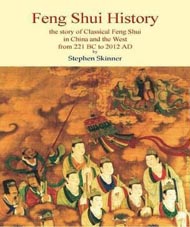Feng Shui History
the story of Classical Feng Shui in China and the West from 221 BC tot 2012 AD
Stephen Skinner
Published by Golden Hoard Press, 2013
Feng Shui History tracks the evolution of feng shui in China from 221 BC till the present day, and then its
spread throughout SE Asia and finally to the rest of the world in the last 35 years.
This has never been done before in English. The only information on the history of feng shui occurs as scattered
chapters in a number of books, but these books often repeat the same tired generalisations, and include many
largely erroneous statements such as:
|
This book has been meticulously researched, from authoritative Chinese texts and the analysis of many antique lo p'ans.
It contains the biographical details of many masters, and tracks the changes in feng shui theory and practice over time.
As well as chapters on feng shui in China from 221 BC to the present day, the book tracks the spread of modern day
feng shui in Singapore, Hong Kong, Taiwan, Korea, US, UK and Australia in the 20th and 21st century, bringing it completely
up to date.
The most famous masters, clients, scandals, books, events, Conferences and developments in feng shui methods are recounted
in detail, with an index covering literally hundreds of names.
Stephen Skinner began his career as a geography lecturer at what is now the University of Technology in Sydney.
Stephen Skinner introduced feng shui to the West with the publication of The Living Earth manual of Feng Shui,
the first 20th century English book on feng shui in 1976. With the publication from 1998-2001 of the magazine Feng Shui for Modern Living
both in English and also in Chinese, Stephen helped to spread interest in feng shui worldwide and outside of the Chinese speaking world.
His intention has always been to propagate accurate knowledge about feng shui, so that feng shui is seen as a practical rather
than a mystical knowledge. He has always striven to have feng shui understood as a scientific practice, one which can reliably be
applied to all habitations, to improve the lives of those living there, a repeatable (and therefore scientific) practice,
rather than a mass of conflicting and semi-mystical doctrines.
He was the first to fully document in English the rings of the lo p'an (luo pan) in his comprehensive
Guide to the Feng Shui Compass: a Compendium of Classical Feng Shui.
Now he has created the first history of Classical feng shui, documenting its 2000 years of development in China,
its spread throughout South East Asia, and finally its acceptance, or at least its awareness in the Western world.
He was and is still a prime mover in both establishing feng shui as a precise discipline, and in bringing its benefits to
the English speaking world.
He is the author of more than a dozen books on feng shui, including translations of 4 Chinese classics by Chang Ping Lin from
1739, and the Tibetan Oracle, a study of feng shui and 5 Element practice imported into Tibet in the 9th century.
Stephen lives in Singapore, and is doing his Ph.D in Classics. He has written more than 35 books, translated into more than
twenty different languages including Chinese, Japanese, Korean, Bahasa Melayu, and almost all modern European languages.
(The text above comes from the inside flaps of the book)

